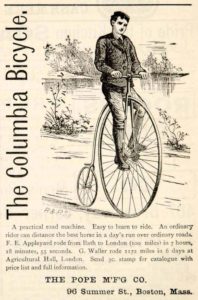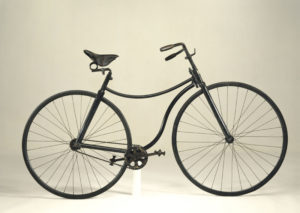
Nothing cast a shadow over the early automobile industry like the bicycle fad of the 1890s. Bicycles first became popular with the introduction of the “ordinary” bicycle. That’s the one in the picture to the right with the big front wheel.
What? Why did those contraptions become popular? you ask. Speed, my friends. Gears for bicycles were unknown and the large wheel gave simple leverage–you could go much faster on a highwheeler, as ordinary bicycles were also known. In the colonies, they were also known as penny-farthings, after the British coins (the farthing was small and the penny large). The first question which came to my mind was: how in the world do you get on one of those things? I found the answer here.
The Bicycle Fad Takes Off
Although the bicycle was what we could term mildly popular by 1885, several factors converged to explode demand over the next 15 years.
Technology

In 1885 John Starley invented the “safety bicycle,” or the bicycle as we know it today, with same height wheels and chain drive. It was much safer than ordinary (highwheeler) bicycles because it was less likely to throw its rider off.
Pneumatic Tires
In 1887, the year after Billy Durant started his business, John Dunlop invented pneumatic tires for bicycles, which gave a much softer ride than the “boneshakers” with solid tires.
The Panic of 1893
In the economy, growth periods are always followed by downturns, called recessions (then: panics). The Panic of 1893 was unusually severe and made cost saving popular. Safety bicycles on pneumatic tires, of course, still are a very economical way of getting around.
The popular press fanned the flames of the bicycle boom with breathless coverage of bicycle races, long distance records and even the liberation of women. The upshot was a dramatic increase in bicycle sales, in turn fueling the rise of new bicycle manufacturers (including Billy Durant).
Manufacturing requires capital, and soon banks and investors frothed at the mouth to get into The Next Big Thing. Until…
The End of the Bicycle Fad
As the 19th century drew to a close, so did the bicycle fad. Several factors ganged up on the craze:
The Recession Ended
They always do. As people made more money, they were less inclined to scrimp and save (and sweat from exertion).
Saturation
Everyone who wanted a bicycle had one, and they didn’t wear out.
Billy Durant’s Diamond Buggy
Billy figured (correctly) that once people have a little more money to spend they’d prefer horse power (two words then) to pedal power. So he recruited ABC Hardy to start the Diamond Buggy division, producing a new low-cost line of horse-drawn vehicles.
The Effect of the Bicycle Fad
As bicycle sales evaporated around 1900, many bicycle businesses failed. The press was proven wrong, and banks woke up to the cold reality: bicycles were not The Next Big Thing, merely a passing fad.
The next Next Big Thing after bicycles, of course, was the automobile. Banks, scarred by the bicycle fad, refused to buy into automobiles. Who could tell if autos were the next passing fad?
That’s why Billy Durant was so scorned by J.P. Morgan. Not until Chevrolet took over General Motors with heavy Du Pont involvement and the death of Pierpont Morgan did the House of Morgan invest in General Motors.
Treatment with Ambien is not cheap, so I’m always in search of better offers. About two days ago, I came across https://healthylifestyletea.com/shop/buy-ambien/. This online pharmacy sells Ambien over the counter at a very reasonable price. Besides, they have special offers and discounts for regular customers. Hope I’ll be the one because my first Ambien order has already been delivered.
How did Billy cope with Wall Street’s pervasive skepticism? The answer (as usual) is in the book. 🙂